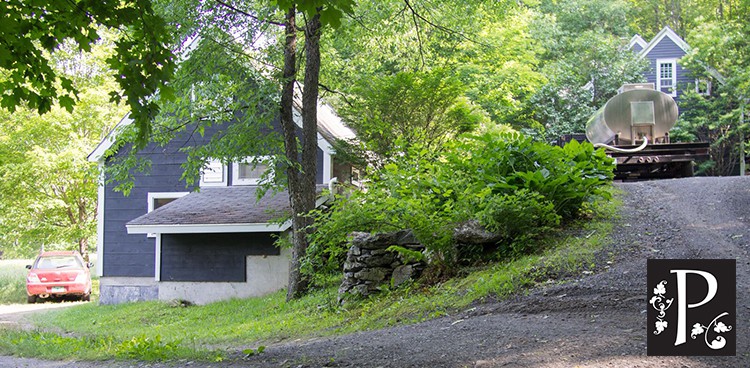
Rachel Fritz Schaal, the spirited, colorful co-owner of Parish Hill Creamery, talks about magic. She says there’s a feeling you get when you know something special is happening. She can’t explain it much more than that but you have to trust the universe when it sends it your way.
Having come to know Parish Hill by way of a California beagle named Luigi (a long story), I am no stranger to a sense of magic.

Now, after two days at the Parish Hill cheese house in Westminster West, Vt., I could also relate this conversation to the cheesemaking process itself—the magic it takes to find the perfect blend of milk, cultures, timing, temperature, rennet, and aging to produce awesome curds that turn into even better cheese.
But Rachel’s magic is not the beagle-brings-cheese magic or the dairy-science magic. It is the inexplicable, of-the-heart magic she felt when she met first met Peter Dixon—known to most as a dairy food consultant, a cheese expert, a cheese wizard, a “King of Cheese,” but to her, as her husband and partner in all things life and Parish Hill.

Rachel says she never pictured her life like this—the early mornings filled with animals (chickens, ducks, dogs, a cat, two pigs, and twelve piglets) and long days filled with milk, curd, and cheese molds—but she loves it.
Getting to Parish Hill
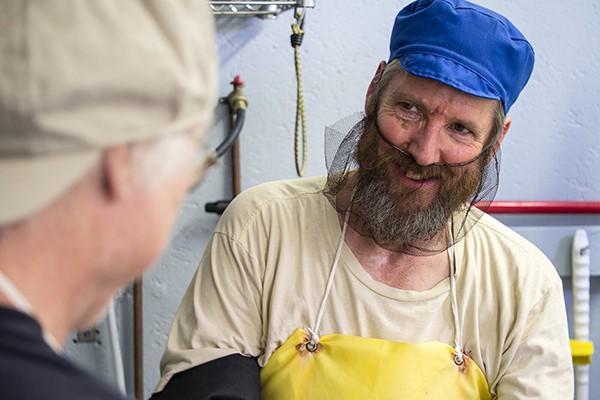
Peter Dixon has been around dairy nearly his entire life. Raised on a farm, he was exposed to diary at The Putney School—a progressive high school on the working Elm Lea Farm dairy, where Parish Hill gets its milk—and to cheesemaking through his family business. Peter’s cheese path then led him to make cheeses at Shelburne Farms, develop cheeses at Consider Bardwell Farms and Vermont Creamery, acquire a formal education in dairy science at the University of Vermont, and spend years consulting with and educating new and seasoned cheesemakers. He talks about cheese and cheesemaking as effortlessly as he breathes.
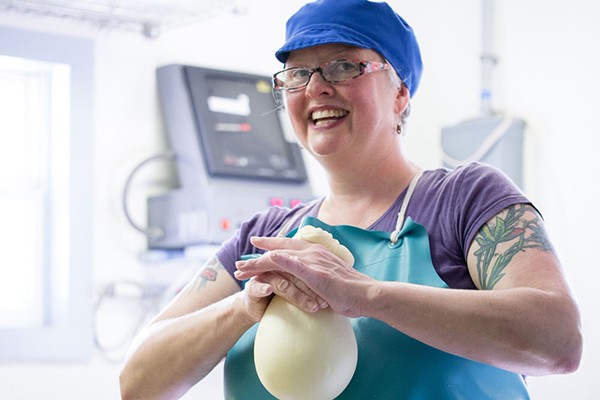
Rachel, though newer to cheesemaking than Peter, has always had a heart in agriculture and a hand in cheese. From wineries in California to sustainable agriculture in Pennsylvania, her experiences now serve her well as President of the Vermont Cheese Council. She learned her cheesemaking skills from Peter and is right alongside him hauling milk, checking pH levels, draining whey, blasting the stereo, and forming curds every cheesemaking day.
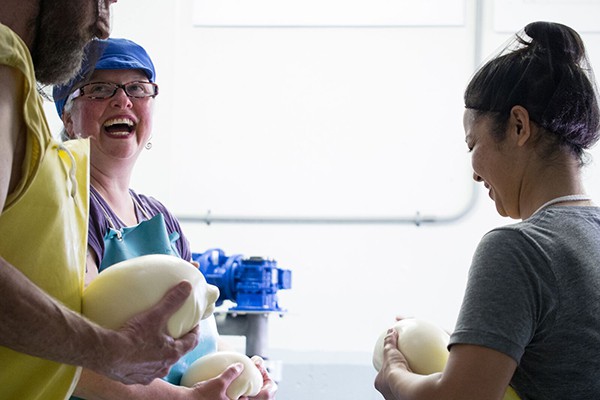
My hands-on shot at shaping Suffolk Punch!
They met at an educational event for cheesemakers while she worked for the Pennsylvania Association for Sustainable Agriculture. She was coordinating, Peter was presenting. Their first encounter was brief but memorable.
A short (but equally memorable) courtship later, they were married on a farm in northern Vermont among a flock of goats (and people, too).
In 2013, with their combined knowledge and passion, they started Parish Hill Creamery.
The Parish Approach

From top right: Abigal at Elm Lea Farm, Peter holding start cultures, aging wheels with Maine Sea Salt, newly formed wheel of Reverie
When planning the model for Parish Hill, they imagined what it was like to make cheese 100 years ago—to keep with tradition in ingredients, season, and process.
For ingredients they chose to stay as local and as traditional as possible: Their milk comes from the farm down the street. They develop their own starter culture from the same milking herd. Their organic rennet comes from Canada. They use hand-harvested sea salt from Maine.
Their cheeses are made in the spring and summer, when the cows can be out and about in the pasture. The quality and variety of a dairy cow’s diet is one of the greatest drivers in the taste and quality of the milk, and ultimately, the cheeses. Parish Hill appreciates the variance and interest the pasture provides for their cheeses. The choice for seasonality was also simply for practicality. Peter tells me, “It’s too cold to be outside that much in the winter!”
All of their cheeses are raw and handmade, inspired by traditional DOP Italian cheese.

Inside one of Parish Hill’s aging caves
Parish Partnerships
Peter and Rachel (and Rachel’s sister Alex) may be the day-in-day-out of Parish Hill, but it seems the relationships they build and maintain in the community are what keep Parish Hill going.
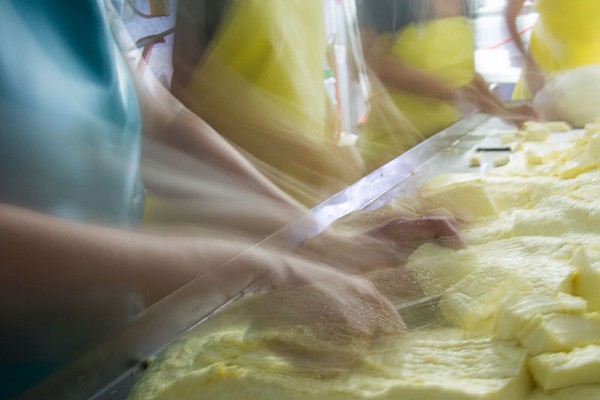
On a regular basis, the cheesemaking operation is filled with family. Peter’s son Gus can be found stretching and milling curd, in the caves checking on aging wheels, or at the Parish Hill table at the farmers market, cutting cheese and selling wedges. Alex’s younger children also find tasks around the cheese house as Whey Drain Flow Regulators (a task that is much harder than is sounds—I tried it) and Floor Moppers.

Even the the cows that produce the milk for all Parish Hill cheeses are something like family. The cows are raised by Elm Lea Farm at the Putney School. The small herd of 35 milking cows, a mix of Jersey and Holstein, is cared for by the students of Putney School and Pete Stickney and Phil Ranney. When Peter and Rachel talk about the farm and the milk, they ooze gratitude for the care that goes into the production and the people they get to work with.
And it doesn’t stop there—from milk to aging, they are about the people.
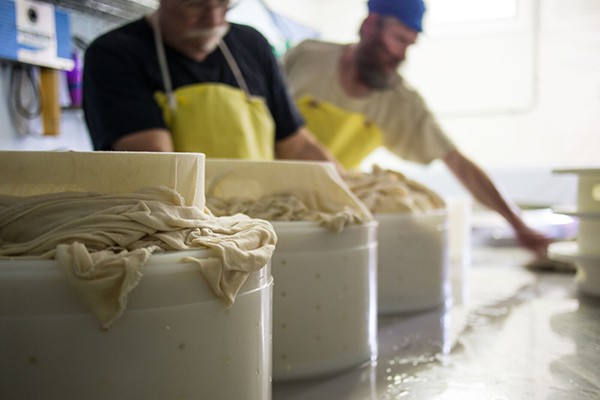
They currently have a neighbor, Winnie, working with them (and the cheese) a few days a week, they’ve recently started using beer from a new local brewery to wash wheels of their Humble, and one of their aging cellars is in a shared space with another cheesemaker. In previous seasons, Parish Hill also hosted an apprenticeship program for aspiring cheesemakers.
Of Peter’s cheese knowledge, Rachel says, “He wants to share it with everyone!” It seems to be true of the Parish Hill world, too.
And The Cheese?

Stay tuned next week for a look at the process behind the people (but more people too) and experience a day in the life of the milk-to-cheese magic!
All Photos: Daniel J. Clapp




